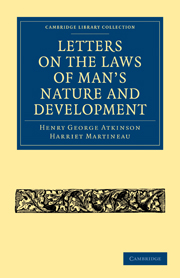Book contents
- Frontmatter
- Preface
- Mottoes
- Contents
- Letter. 1 Inquiry for a Basis
- Letter. 2 Proposal of a Basis
- Letter. 3 Preparation of the Ground
- Letter. 4 What is the Brain?
- Letter. 5 Inquiry about its Structure
- Letter. 6 Early days of Phrenology
- Letter. 7 Inquiry for New Discoveries
- Letter. 8 Methods of New Discovery. Organic Arrangement of the Brain
- Letter. 9 Illustrative Cases
- Letter. 10 Organic Arrangement of the Cerebrum
- Letter. 11 Dr. Howe's Report on Idiocy
- Letter. 12 The Senses and Nervous System
- Letter. 13 Illustrative Comment
- Letter. 14 Facts about the Senses under various conditions
- Letter. 15 Raising questions
- Letter. 16 Bacon, on Matter and Causation. Inferences and Dreams. Association of Ideas
- Letter. 17 Nothing
- Letter. 18 Knowledge and Notions. Results of each
- Letter. 19 Release from Notions. Entrance upon Knowledge
- Letter. 20 Natural History of Superstition
- Letter. 21 Theology and Science
- Letter. 22 Central Law and Pervasive Unity. Light. Sense of Identity. Ghost-seeing. Unrevealed Human Relations
- Letter. 23 Position and Privilege of Truth-seekers
- Letter. 24 Position and Privilege of Truth-speakers
- Appendix
Letter. 10 - Organic Arrangement of the Cerebrum
Published online by Cambridge University Press: 29 August 2010
- Frontmatter
- Preface
- Mottoes
- Contents
- Letter. 1 Inquiry for a Basis
- Letter. 2 Proposal of a Basis
- Letter. 3 Preparation of the Ground
- Letter. 4 What is the Brain?
- Letter. 5 Inquiry about its Structure
- Letter. 6 Early days of Phrenology
- Letter. 7 Inquiry for New Discoveries
- Letter. 8 Methods of New Discovery. Organic Arrangement of the Brain
- Letter. 9 Illustrative Cases
- Letter. 10 Organic Arrangement of the Cerebrum
- Letter. 11 Dr. Howe's Report on Idiocy
- Letter. 12 The Senses and Nervous System
- Letter. 13 Illustrative Comment
- Letter. 14 Facts about the Senses under various conditions
- Letter. 15 Raising questions
- Letter. 16 Bacon, on Matter and Causation. Inferences and Dreams. Association of Ideas
- Letter. 17 Nothing
- Letter. 18 Knowledge and Notions. Results of each
- Letter. 19 Release from Notions. Entrance upon Knowledge
- Letter. 20 Natural History of Superstition
- Letter. 21 Theology and Science
- Letter. 22 Central Law and Pervasive Unity. Light. Sense of Identity. Ghost-seeing. Unrevealed Human Relations
- Letter. 23 Position and Privilege of Truth-seekers
- Letter. 24 Position and Privilege of Truth-speakers
- Appendix
Summary
H. G. A. to H. M.
It appears to me that the senses are simply instrumental; that is, the media or conditions by which impressions of external objects are, under ordinary circumstances, made to the brain. I mean that there is no sense or consciousness out of the brain: that the entire perceptive power is within the brain. It is natural that we should expect to trace the nerves of each sense direct to the organ in the brain appropriate to that sense. However, this cannot be done. The nerves from the eye, for instance, do not pass direct to the perceptive faculties, but, like the other sense nerves, pass on to masses of grey matter at the back of the brain, which, however, communicates with the cerebrum and cerebellum. It occurs to me, therefore, that it is very possible that the sense impressions do not pass along the nerves into the perceptive region of the brain as electricity passes along wires; but that the nerves of sense maintain a receptive medium, or condition of that medium, the impressions on which act directly on the brain organ or organs relating to such impressions. I think that the muscular and executive forces of the system are more nearly allied to electricity, and the receptive and mental powers rather to magnetism. I think also that the passage of the impressions from the nerves of sense to the organs of the brain resembles that from the external object to the sense; as in the case of the retina in seeing: and that the combined action and associations in the brain,—in our thoughts,—occur in a similar way.
- Type
- Chapter
- Information
- Letters on the Laws of Man's Nature and Development , pp. 72 - 89Publisher: Cambridge University PressPrint publication year: 2009First published in: 1851



